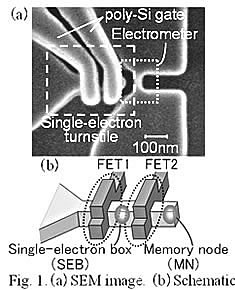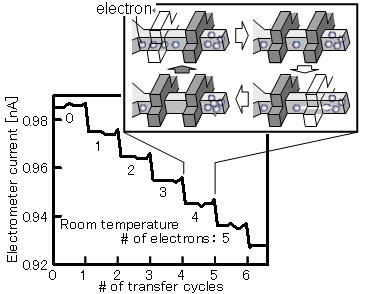with silicon nanodevics
Katsuhiko Nishiguchi, Akira Fujiwara, Yukinori Ono, Hiroshi Inokawa, and
*Yasuo
Takahashi
Physical Science Laboratory, *Present address: Hokkaido university
Single-electron devices (SEDs) have great attention because
of their ultra-low power consumption. The single-electron turnstile, which
transfers electrons one by one, is a member of the SED family and is a promising
device for an architecture which treats one electron. This architecture requires
precise control of electron movement and accurate detection of single electrons.
Although various studies demonstrated these two key points, the operation
temperature has remained quite low because the devices were not small enough
to prevent thermal energy disturbing electron movement and to gain sufficient
sensitivity for single-electron detection.
We thus proposed the silicon nanodevices which can transfer and detect single
electrons and fabricated them on a silicon-on-insulator (SOI) (Fig. 1) [1].
The single-electron turnstile is composed of two wire-FETs. A single-electron
box (SEB) is electrically defined between FETs. By turning on FET1 and FET2
alternately, the single electron is transferred to the memory node (MN) through
the SEB (the inset of Fig. 2). One transfer cycle for injecting the single
electron in the MN is composed of four steps shown in the inset of Fig. 2
[2]. By repeating the transfer cycles, the electrons are transferred one by
one. The single electrons transferred into the MN are detected by an electrometer
capacitively coupled to the MN. The electrometer is carefully positioned close
to the MN so that the sensitivity of the electrometer is high enough to detect
single electrons in the MN [3].
Figure 2 shows changes in the electrometer current when transfer cycle was
repeated. Current change per transfer cycle was caused by one electron transfer.
The size reduction of the SEB and optimized operating conditions allowed the
single-electron transfer and detection at room temperature. The present device
using FETs for the electron transfer and storage achieves high-speed transfer
(<10ns) and long retention (>104s). We also demonstrated that the present
device could serve as a multi-level (5 bit) single-electron memory [1].
[1] K. Nishiguchi, et al., International Electron Devices Meeting (IEDM) (2004)
199.
[2] A. Fujiwara, et al., Appl. Phys. Lett. 84 (2004) 1323.
[3] K. Nishiguchi, et al., Appl. Phys. Lett. 85 (2004) 1277.
 |
 |
|
|
view of the single-erectron
turnstile. |
Fig. 2. Single-erectron transfer and derection
|
|